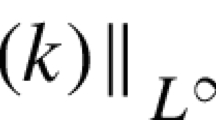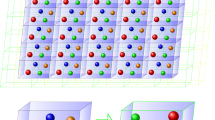Abstract
The kinetic theory is widely used in the description of thermal transport at the micro- and nanoscale. In the theory, it is assumed that heat is carried by quasi-particles, obeying the Boltzmann transport equation. These quasi-particles are sometimes associated with phonons. However, since phonons are not localized in physical space, they cannot play the role of the quasi-particles used in the kinetic theory. In the present paper, we employ another interpretation of quasi-particles, namely wave packets. Our derivation is carried out for an infinite harmonic chain with a given initial temperature distribution. An exact formula describing the time evolution of the kinetic temperature of the chain is derived. A transition from the exact solution to a continuum limit is performed. It is shown that the resulting continuum solution coincides with the solution of the collisionless Boltzmann equation. The transition yields wave packets, localized in space and moving with group velocities. Therefore, the wave packets can be associated with quasi-particles. It is shown that the quasi-particle has finite lifetime and that its position is determined with some uncertainty.


Similar content being viewed by others
Notes
In the present paper, heat transport in dielectrics is considered, and therefore the contribution of electrons to heat transport is ignored.
In harmonic crystals, the particles interact via linearized forces.
Further, we consider an infinite crystal as a limiting case, where N tends to infinity.
Choosing parameters \(C_j\) in (1), one can describe any linear pairwise interactions in the chain.
Since the velocity is real, the exponent in formula (6) can be replaced by the cosine function.
To prove this statement, one can replace the cosine by complex exponents.
Here, the relation \(\Bigl \langle {v_i v_i^*}\Bigr \rangle = \Bigl \langle {v_i^2}\Bigr \rangle\) was used, where \(*\) stands for the complex conjugate.
Since the expression in (8) is periodic, summation can be carried out over the interval, which is symmetric with respect to zero. In the limit of an infinite crystal, the interval becomes a set of integers.
Here, the identity \(\omega '(q_1)= -\omega '(-q_1)\) is used.
For finite \(\Delta N\), the integral in formula (22) can be represented via the sine integral.
The difference is caused by the fast process, which is only present in the lattice dynamics solution (see Sect. 3). The fast process leads to a reduction in the temperature by a factor of 2. The solutions coincide exactly if the initial temperature in the kinetic theory is interpreted as a result of the fast process.
References
Lepri, S., Livi, R., Politi, A.: Thermal conduction in classical low-dimensional lattices. Phys. Rep. 377, 1 (2003)
Dhar, A.: Heat transport in low-dimensional systems. Adv. Phys. 457–537 (2008)
Bonetto, F., Lebowitz, J.L., Rey-Bellet, L.: Fourier’s law: a challenge to theorists. Math. Phys. 128–150 (2000)
Gendelman, O.V., Shvartsman, R., Madar, B., Savin, A.V.: Nonstationary heat conduction in one-dimensional models with substrate potential. Phys. Rev. E 85(1), 011105 (2012)
Chang, C.W., Okawa, D., Garcia, H., Majumdar, A., Zettl, A.: Breakdown of Fourier’s law in nanotube thermal conductors. Phys. Rev. Lett. 101, 075903 (2008)
Johnson, J.A., Maznev, A.A., Cuffe, J., Eliason, J.K., Minnich, A.J., Kehoe, T., Sotomayor Torres, C.M., Chen, G., Nelson, K.A.: Direct measurement of room-temperature nondiffusive thermal transport over micron distances in a silicon membrane. Phys. Rev. Lett. 110, 025901 (2013)
Hsiao, T.K., Chang, H.K., Liou, S.-C., Chu, M.-W., Lee, S.-C., Chang, C.-W.: Observation of room-temperature ballistic thermal conduction persisting over 8.3 \(\upmu\)m SiGe nanowires. Nat. Nanotech 8(7), 534 (2013)
Anufriev, R., Gluchko, S., Volz, S., Nomura, M.: Quasi-ballistic heat conduction due to Levy phonon flights in silicon nanowires. ACS Nano (2018). https://doi.org/10.1021/acsnano.8b07597
Klemens, P.G.: The thermal conductivity of dielectric solids at low temperatures. Proc. R. Soc. Lond. A 208(1092), 108–133 (1951)
Krivtsov, A.M.: Heat transfer in infinite harmonic one dimensional crystals. Dokl. Phys. 60(9), 407 (2015)
Kuzkin, V.A., Krivtsov, A.M.: Fast and slow thermal processes in harmonic scalar lattices. J. Phys. Condens. Matter 29, 505401 (2017)
Krivtsov, A.M.: The ballistic heat equation for a one-dimensional harmonic crystal. In: Altenbach, H., Belyaev, A., Eremeyev, V.A., Krivtsov, A., Porubov, A.V. (eds.) Dynamical Processes in Generalized Continua and Structures. Springer, Berlin (2019)
Kuzkin, V.A.: Unsteady ballistic heat transport in harmonic crystals with polyatomic unit cell. Cont. Mech. Thermodyn. 31, 1573–1599 (2019)
Gavrilov, S.N., Krivtsov, A.M., Tsvetkov, D.V.: Heat transfer in a one-dimensional harmonic crystal in a viscous environment subjected to an external heat supply. Cont. Mech. Thermodyn. 31(1), 255–272 (2019)
Gavrilov, S.N., Krivtsov, A.M.: Steady-state kinetic temperature distribution in a two-dimensional square harmonic scalar lattice lying in a viscous environment and subjected to a point heat source. Continuum Mech. Thermodyn. (2019). https://doi.org/10.1007/s00161-019-00782-2
Sokolov, A.A., Müller, W.H., Porubov, A.V.: Heat conduction in 1D harmonic crystal: Discrete and continuum approaches. Int. J. Heat Mass Transf. (2020)
Guzev, M.A.: The exact formula for the temperature of a one-dimensional crystal. Dal’nevost. Mat. Zh. 18, 39 (2018)
Peierls, R.: Zur kinetischen Theorie der Wärmeleitung in Kristallen. Ann. Phys. 3, 1055 (1929)
Cipriani, P., Denisov, S., Politi, A.: From anomalous energy diffusion to Levy walks and heat conductivity in one-dimensional systems. Phys. Rev. Lett. 94, 244301 (2005)
Mendl, C.B., Spohn, H.: Dynamic correlators of Fermi-Pasta-Ulam chains and nonlinear fluctuating hydrodynamics. Phys. Rev. Lett. 111, 230601 (2013)
Dhar, A., Kundu, A., Kundu, A.: Anomalous heat transport in one dimensional systems: a description using non-local fractional-type diffusion equation. Front. Phys. (2019)
Cahill, D.G., Ford, W.K., Goodson, K.E., Mahan, G.D., Majumdar, A., Maris, H.J., Merlin, R., Phillpot, S.R.: Nanoscale thermal transport. J. Appl. Phys. 93, 793 (2003)
Spohn, H.: The phonon Boltzmann equation, properties and link to weakly anharmonic lattice dynamics. J. Stat. Phys. 124(2–4), 1041–1104 (2006)
Mielke, A.: Macroscopic behavior of microscopic oscillations in harmonic lattices via Wigner–Husimi transforms. Arch. Ration. Mech. Anal. 181, 401 (2006)
Lukkarinen, J.: Kinetic theory of phonons in weakly anharmonic particle chains. In: Lepri S. (eds) Thermal Transport in Low Dimensions. Lecture Notes in Physics, vol. 921. Springer, Cham (2016)
Tamm, I.E.: Über die Quantentheorie der molekularen Lichtzerstreuung in festen Körpern. Zeitschr. Phys. 60(5–6), 345–363 (1930)
Frenkel, J.I.: Wave Mechanics. Clarendon Press, Oxford (1932)
Indeitsev, D.A., Naumov, V.N., Semenov, B.N., Belyaev, A.K.: Thermoelastic waves in a continuum with complex structure. Z. Angew. Math. Mech. 89, 279 (2009)
Huberman, S., Duncan, R.A., Chen, K., Song, B., Chiloyan, V., Ding, Z., Maznev, A.A., Chen, G., Nelson, K.A.: Observation of second sound in graphite at temperatures above 100 K. Science (2019). https://doi.org/10.1126/science.aav3548
Hoover, W.G., Hoover, C.G.: Nonequilibrium temperature and thermometry in heat-conducting \(\phi -4\) models. Phys. Rev. E 77, 041104 (2008)
Krivtsov, A.M., Kuzkin, V.A.: Discrete and continuum thermomechanics. In: Altenbach, H., Öchsner, A. (eds). Encyclopedia of Continuum Mechanics. Springer, Berlin (2018)
Xiong, D., Thiel, F., Barkai, E.: Using Hilbert transform and classical chains to simulate quantum walks. Phys. Rev. E 96, 022114 (2017)
Paul, J., Gendelman, O.V.: Kapitza resistance in basic chain models with isolated defects. Phys. Lett. A 384(10), 126220 (2020)
Acknowledgements
The authors are deeply grateful to S.N. Gavrilov and A.A. Sokolov for useful discussions and to O. Bain for proofreading of the manuscript. This work was financially supported by the Russian Science Foundation (Grant No. 19-41-04106). Valuable comments of the reviewers are highly appreciated.
Author information
Authors and Affiliations
Corresponding author
Ethics declarations
Conflict of interest
The authors declare that they have no conflict of interest.
Additional information
Publisher's Note
Springer Nature remains neutral with regard to jurisdictional claims in published maps and institutional affiliations.
Appendices
Appendix 1: Change of the summation limits
We show that in formula (8) the summation from 0 to \(N-1\) can be replaced by a summation from \(M-N+1\) to M (for \(M < N\)) as follows:
Here, the periodicity of the problem \(T_j^0= T_{j-N}^0\) is used. Similarly, we show that the following identity is satisfied:
Appendix 2: Derivation of the formula for \(\varphi\)
Consider the derivation of formula (19) for function \(\varphi\). By definition,
We make the following transformations at the right side of formula (49):
Substitution of the identities
into (50) yields expression (19) for \(\varphi\).
Appendix 3: Derivation of the formula for \(\psi\)
We derive the approximate expression (24) for \(\psi\) in the limit \(\Delta N \gg 1\), \(a\Delta N \ll L\). We make the following transformations:
Here, \(q_1 \in [0; \pi ]\), \(\omega ' = \omega '(q_1)\). Calculation of the integral at the right side of formula (52) yields formula (24):
Here, \(a\Delta N\) is small compared to the macroscopic length scale L. Therefore, for \(a\Delta N \ll L\), function \(\psi\) can be replaced by the Dirac delta function.
Rights and permissions
About this article
Cite this article
Kuzkin, V.A., Krivtsov, A.M. Unsteady ballistic heat transport: linking lattice dynamics and kinetic theory. Acta Mech 232, 1983–1996 (2021). https://doi.org/10.1007/s00707-020-02927-w
Received:
Revised:
Accepted:
Published:
Issue Date:
DOI: https://doi.org/10.1007/s00707-020-02927-w




